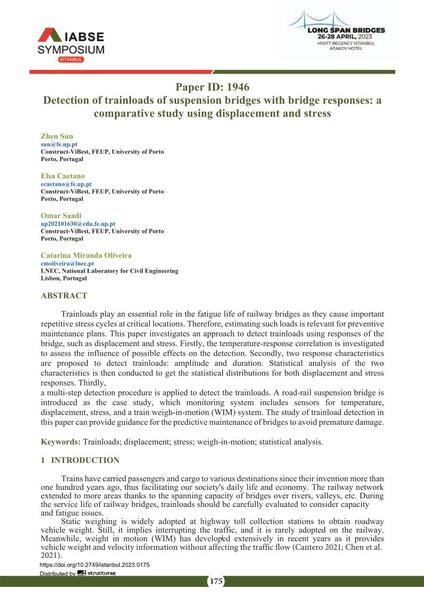Detection of trainloads of suspension bridges with bridge responses: a comparative study using displacement and stress

|
|
|||||||||||
Bibliografische Angaben
| Autor(en): |
Zhen Sun
(Construct-ViBest, FEUP, University of Porto Porto, Portugal)
Elsa Caetano (Construct-ViBest, FEUP, University of Porto Porto, Portugal) Omar Saadi (Construct-ViBest, FEUP, University of Porto Porto, Portugal) Catarina Miranda Oliveira (LNEC, National Laboratory for Civil Engineering Lisbon, Portugal) |
||||
|---|---|---|---|---|---|
| Medium: | Tagungsbeitrag | ||||
| Sprache(n): | Englisch | ||||
| Tagung: | IABSE Symposium: Long Span Bridges, Istanbul, Turkey, 26-28 April 2023 | ||||
| Veröffentlicht in: | IABSE Symposium Istanbul 2023 | ||||
|
|||||
| Seite(n): | 175-181 | ||||
| Anzahl der Seiten (im PDF): | 7 | ||||
| Jahr: | 2023 | ||||
| DOI: | 10.2749/istanbul.2023.0175 | ||||
| Abstrakt: |
Trainloads play an essential role in the fatigue life of railway bridges as they cause important repetitive stress cycles at critical locations. Therefore, estimating such loads is relevant for preventive maintenance plans. This paper investigates an approach to detect trainloads using responses of the bridge, such as displacement and stress. Firstly, the temperature-response correlation is investigated to assess the influence of possible effects on the detection. Secondly, two response characteristics are proposed to detect trainloads: amplitude and duration. Statistical analysis of the two characteristics is then conducted to get the statistical distributions for both displacement and stress responses. Thirdly, a multi-step detection procedure is applied to detect the trainloads. A road-rail suspension bridge is introduced as the case study, which monitoring system includes sensors for temperature, displacement, stress, and a train weigh-in-motion (WIM) system. The study of trainload detection in this paper can provide guidance for the predictive maintenance of bridges to avoid premature damage. |
||||
| Stichwörter: |
Spannung Verschiebung
|
||||
